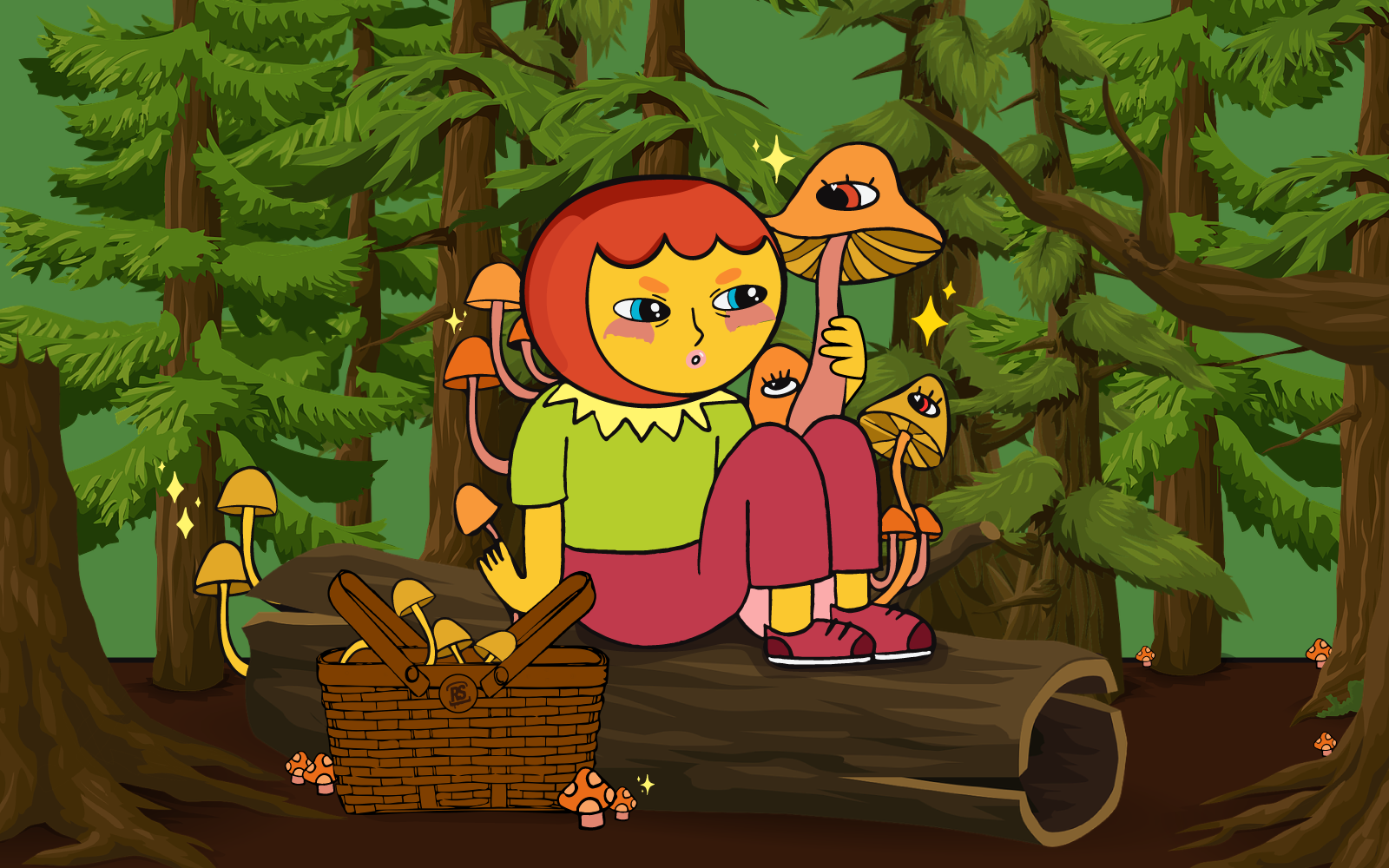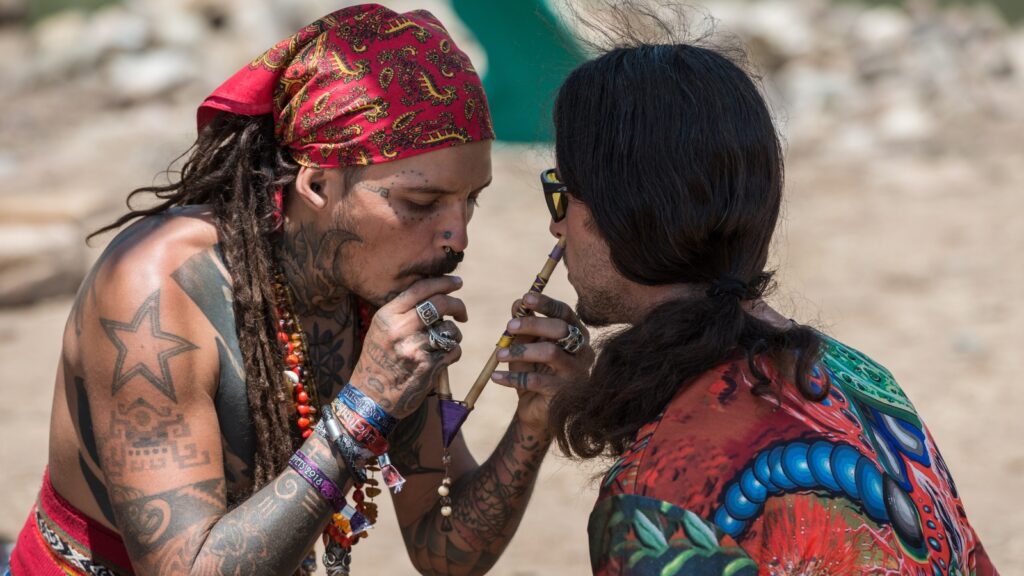Foraging for psilocybin mushrooms is a lot more than just a prerequisite to a potentially transformative entheogenic experience. It’s also a fun and rewarding way to get out in nature and delve into the mysterious and fascinating world of mycology. However, given that the majority of mushrooms are inedible and some are highly poisonous, shroom hunting is an activity where you definitely do not want to be flying blind. This article aims to be an introductory resource that will get you safely started on your foraging journey. To that end, we will take a high-level overview of the major climates and habitats where psilocybin mushrooms grow. We’ll also discuss how to find and identify some of the most popular shroom species.
What is Foraging?
Mushroom foraging is the practice of searching for wild mushrooms. This is done either to pick and sell/eat them, to conduct mycological research, or for its own sake as a fun outdoor hobby. Many foragers are after exotic choice edibles like chantarelles, morels, oysters, and truffles, which can sell for surprisingly high prices.
Exotic mushroom foraging is a common activity in Europe, Asia, and North America. Psilocybin mushroom foraging is no exception. Psilocybin mushrooms pioneers introduced them to the national consciousness in the late 1950s and discovered them to be prolific outside of South America. Interest in mushroom foraging grew dramatically during the countercultural 1960s and 70s. Legions of folks throughout the northwestern and southeastern United States began to head to the fields and woods in search of active species. With that tidal wave of interest came a number of stories involving accidental fatal poisonings.
To this day, these unfortunate misidentifications highlight the crucial importance of knowing how to differentiate the deadly from the magical. But once adequately prepared and informed of the dangerous varieties, shroom hunting is generally very safe. Most foragers have success during the damp months of late summer and early fall. This is when most shrooms are likely to be fruiting. Later, we will discuss specific habitats and climates that are favorable for certain species.
Where Do Shrooms Grow?
Psilocybin mushrooms are a diverse group of fungi that grow virtually everywhere around the world. There are more than 200 species across 12 genera, most of which (116) belong to the genus Psilocybe.
Around the world, psilocybin mushrooms occur naturally on every major continent except for Antarctica. Twenty-two of these species grow in Canada and the United States, particularly along the West Coast, from Northern California to British Columbia. Sixteen species grow in Europe, especially in central and northern Europe. Mexico is home to the largest number of species, with 53 currently known. A further 15 exist in Asia, four in Africa, and 19 in Oceania.
Unlike photosynthesizing plants, fungi use their underground mycelium to feed and grow. The mycelium releases acids and enzymes that break down the substrates they colonize into simpler molecules. The fungi then absorb and use these as energy for respiration, and to grow their mycelial networks and fruiting bodies. Psilocybin mushrooms are saprophytes, meaning they feed and grow on decomposing plant and animal matter.
Saprophytes can be further classified based on the type of substrate that they prefer. Lignicolous (wood-loving) species grow and live on woody debris, such as dead leaves, sticks, and bark mulch. Humicolous (humus-loving) species thrive in humus and soils like red clay and loam. Coprophilous species thrive in grasslands, where they selectively colonize the dung of grazing herbivores such as cows, horses, goats, and even elephants.
Ideal Mushroom Environment
Psilocybin mushrooms, or really mushrooms in general, require three crucial environmental factors to grow: ample amounts of humidity (usually above 80%), indirect lighting to stimulate fruiting, and mild or warm temperatures. If these conditions are met, then only the preferred substrate of any given species is required. Let’s take a closer look at the ideal mushroom environment, including the climates and habitats where they flourish.
Climate
Psilocybin mushrooms grow naturally in tropical, subtropical, and temperate regions around the world.
In the United States, over a dozen species, overwhelmingly the wood-loving species, thrive in the Pacific Northwest. This region has a temperate climate inland and an oceanic climate along the coast. These climates support the highly potent “caramel-capped” Psilocybes, such as P. cyanescens and P. azurescens. Northwest and Central Europe, southeast Australia, and New Zealand also have oceanic climates. All of these regions support wood-loving species that fruit primarily in the fall when temperatures drop.
Many grass-loving species prefer humid subtropical regions. For instance, the highly popular P. cubensis may fruit nearly all year long. But most often they flourish on warm summer days after heavy rainfall. In the United States, this climate is found in Florida and around the Gulf Coast. Around the world, subtropical climates are found in eastern Australia, Southeast Asia, and much of South America. All of these regions are home to P. cubensis and other grass-loving shrooms.
Habitat
As mentioned earlier, psilocybin species may differ in the substrate they prefer to inhabit, and different habitats support these substrates.
Grassland habitats are home to small, bell-shaped Psilocybes like P. semilanceata and P. mexicana. These Psilocybes fruit from a wide variety of grasses. Such grasses include dune grasses, bentgrass, bunch grasses, fescues, sedges, and perennial ryes. Some species, like P. stuntzii, may even grow in highly urbanized areas—including in lawns, parks, and in wood chips around landscaped buildings.
Rarer psilocybes like P. hoogshagenii prefer nutrient-rich humus and clay soils. You can find larger and more abundant grass-loving species like P. cubensis, Panaeolus cyanescens, and Panaeolus subbalteatus in wet grassy fields and uncultivated pastures rich in manure and cattle dung. These dung-loving species tend to flourish for just a few days, due to the temporary nature of their habitat.
Wood-loving Psilocybes grow best in disturbed habitats like moist, well-mulched gardens, at the edges of roads, and debris fields with decomposing wood. Some are known to thrive around construction sites and landslides, until these habitats no longer have the nutrients to support their growth. Some wood lovers, such as Psilocybe caerulipes, Psilocybe cyanescens, and Psilocybe serbica can be found in deciduous and coniferous forests. They’re especially prolific in riparian zones, on decaying hardwood near streams, ponds, and lakes.
How to Identify Shrooms
Depending on the species in question, successful shroom identification can range from an easy activity for the amateur to a highly involved, research-based venture for the skilled mycologist. In general, psilocybin-containing species in the Psilocybe, Panaeolus, and Gymnopilus genera are the easiest to identify with certainty for non-mycologists. It’s important to note, however, that if you are not absolutely certain about an ID, do not ingest it or give it to others to ingest. Many species, especially small grass-loving species, can look eerily similar to poisonous or even deadly LBMs (Little Brown Mushrooms). With that said, let’s look at some general characteristics which can help you narrow down the large pool of ID possibilities to a psilocybin mushroom ID.
General Characteristics of Psilocybin Mushrooms
The Bluing Reaction
Psilocybin mushrooms commonly bruise bluish when handled or injured. This occurs when unstable psilocin degrades to certain bluing compounds, catalyzed by enzymes present in the mushroom. Naturally, the more psilocin content there is in the mushroom, the stronger the bluing reaction. Some species will even bruise indigo-black, as with the extremely potent Psilocybe azurescens.
While a great rule of thumb, the absence of a bruising reaction doesn’t definitely indicate you’re not in the presence of a psilocybin mushroom. This is the case with high psilocybin/no psilocin varieties like P. semilanceata. Conversely, some non-psilocybin mushrooms have bluing reactions, most notably a handful of boletes.
Purple-Brown Spore Print
Psilocybin mushrooms in the Psilocybe and Panaeolus genera generally have spore prints that are purplish-brown to black in color. In contrast, highly poisonous species like Pholiotina filaris and the deadly Galerinas have rusty brown spore prints. These species have reportedly grown within inches of Psilocybes on the same substrate. For this reason, I strongly recommend taking a spore print in order to confirm an ID. To take a spore print, simply cut the cap off the fresh specimen and lay it on a piece of white paper, then place a cup over it to lessen dehydration. Over the course of a few hours, the spores will deposit onto the paper, like a unique fingerprint.
Other Characteristics to Look For
Overall, it’s safest to forage for the genera Psilocybe and Panaeolus, considering they don’t contain any poisonous species (unlike Conocybe and Inocybe). Apart from the useful indicators above, some general characteristics of Psilocybes include a nut-brown cap, a lighter-colored cap margin, gill edges usually fringed whitish, and a gelatinous pellicle that can separate from the cap when it is broken apart. Panaeolus species typically dwell in grasslands and in dung. These species have spotted gills when mature, usually with gray and black zones. Overwhelmingly, they are slender mushrooms with conic or hemispheric caps.
Confirming an Identification
For detailed descriptions and pictures of psilocybin mushrooms by species, consider consulting the gold standard of psilocybin mushroom field guides: Psilocybin Mushrooms of the World by Paul Stamets.
To maximize your chances of a positive ID with the help of a field guide or mushroom ID app, collect a large number of specimens. Ideally, choose ones ranging from very young to fully mature. As mushrooms mature, their physical characteristics evolve in a unique way. This includes how the cap changes shape, color, and texture; how the gills and stem meet; and how the veil or veil remnants transform with time. Collect them in a container that lets them breathe (i.e., not plastic bags) and document everything you can about where you found them and what they were growing on.
If you want to further confirm your identification, you can post pictures and descriptions to communities such as the Shroomery identification forum, the Shroom ID subreddit, and various active shroom identification Facebook groups. All of these usually respond quickly (provided you follow their posting guidelines) and can be very helpful in identifying a given psilocybin-containing species.
What to Look For When Foraging for Magic Mushrooms
When beginning to forage in the wild, it’s best to get familiar with the most popular psilocybin mushrooms. These are not only easier to find, but you’re also less likely to confuse them with poisonous or even deadly varieties, given the plethora of information available about them. For more seasoned foragers, here is a list of known active species found in every state and country. This listing can help you narrow down which species to familiarize yourself with before going out to forage.
Psilocybe cubensis
P. cubensis, known as gold caps or cubes, are a highly popular pan-tropical species found growing on the dung of grazing herbivores and in soils rich in manure. P. cubensis is one of the largest and most easily identifiable Psilocybes. Their golden-brown caps measure 0.5–5 inches across, and their stems can reach lengths of over 6 inches. When young, the caps start out bulbous and round and widen with age. You can definitively identify P. cubensis by its dark purple-brown spore prints and deep bluish bruising reaction.
P. cubensis are widespread around the world, particularly in humid and warm climates among grasslands and pastures. In the United States, they commonly grow in the southeastern states from Florida to the Texas Gulf Coast, typically in late spring and early summer. Internationally, they’re found in Southeast Asia, Australia, India, Mexico, Central America, northern South America, and the Caribbean.
Psilocybe semilanceata
P. semilanceata, or the liberty cap, is a grass-loving species known for its broad distribution and ease of identification. The bell-shaped caps normally don’t get bigger than an inch wide, and at most they stand just shy of 4 inches tall. The caps have a prominent umbo and are usually dark chestnut brown in color, which lightens when dried. Liberty caps produce a purplish-brown spore print, which can help to distinguish it from other similar-looking poisonous lawn species like Conocybe apala and Pholiotina rugosa. Note that since liberty caps contain no psilocin (yet are high in its prodrug, psilocybin), they rarely bruise bluish.
Liberty caps grow throughout much of the world in pastures, lawns, and other grassy areas in the fall and early winter. In North America, they are dispersed from Northern California to British Columbia. They also grow in many other countries. These include—but are not limited to—Canada, England, Ireland, France, Germany, Holland, Belgium, Sweden, Norway, Denmark, Switzerland, Italy, Chile, South Africa, New Zealand, Russia, Spain, India, Ukraine, and Pakistan.
Psilocybe cyanescens
P. cyanescens, commonly known simply as cyans, is a moderate-to-highly potent wood-loving species that the mycologist Elsie Wakefield discovered in 1946. They get their nickname “wavy caps” from their undulating or rippled-cap margin at maturity. The caps are caramel-colored when fresh and dark yellowish-brown when dried. When young, cyans have a weblike partial veil that rapidly deteriorates with maturity. Like other highly potent species, cyans bruise deeply bluish, due to their high psilocin content.
P. cyanescens grows in wood chips, sawdust, and woody debris along the edges of lawns and heavily mulched garden beds. They often fruit in large clusters, normally when temperatures drop to 50–65ºF, from late fall to the first frost. In the United States, they grow predominantly on the West Coast, from San Francisco to southern Alaska. Worldwide, they also grow in the United Kingdom, New Zealand, and in many parts of temperate Central Europe.
Psilocybe azurescens
P. azurescens, also known as “azzies,” are a rare and extremely potent psilocybin mushroom found only on the West Coast of the United States. You can identify them by their silky white stems and caramel-colored, convex caps that grow up to 1.5 inches wide. A translucent skin called a pellicle covers these caps. They have a nipple-like bump (or umbo) in the center. Their spore print is dark purplish brown to purplish black. Other features that signal you’re in the presence of azzies are their deep bluing reaction on their flesh and stipe, and their very bitter taste.
P. azurescens are found in the coastal regions of Washington and northern Oregon, especially in or near dune grasses and sandy soils rich in ligneous debris. They can also fruit on deciduous wood chips on lands adjacent to shorelines. Fruiting typically begins in late September and can continue until early January. Similar to the other PNW wood-lover, P. cyanescens, azzies can tolerate cold temperatures.
Panaeolus cyanescens
Not to be confused with Psilocybe cyanescens, Panaeolus/Copelandia cyanescens (or Blue Meanies) is a potent, dung-loving species found in tropical and subtropical regions around the world. When young, this species has a small, bell-shaped cap that becomes convex and can grow up to 1.5 inches across when mature. The cap is light brown at first, becoming pale gray with age. The pale yellowish stem can range in length from 7–12 cm, and will readily turn bluish when injured. After considering these characteristics as well as others, you can definitively identify Pan cyans by its jet black spore sprint.
People on every habitable continent have reported seeing this species. It’s particularly abundant in North and South America, eastern Australia, Europe, North Africa, Southeast Asia, and the Caribbean. In the United States, it’s mostly distributed in Hawaii, Louisiana, Mississippi, and Florida. You can also find them growing on the dung of cow and carabao in humid pastures and fields.
Alternatives to Hunting for Your Shrooms
While mushroom identification guides and articles like this can minimize the potential dangers, mushroom foraging can be an inherently risky activity. In addition, the season or your location may also constrain your efforts. Since the time of year and the place may not lend themselves to any appreciable shroom harvest in the wild, cultivating your own mushrooms at home is a far safer and more sustainable option. Thankfully, it’s not hard to do and requires very few up-front costs to get going.
For beginners, mushroom grow kits let you grow a sizable amount of shrooms in the comfort of your own home with very little effort or time required. For bigger yields and more control over the process, growing magic mushrooms from scratch is a highly recommended way to go. You can do this easily from spores, which are legal in all states except for California, Idaho, and Georgia.
When it comes to available species for growing, the most commonly cultivated is P. cubensis. This is because it’s less finicky than other species and will easily grow in a variety of environmental conditions. P. cubensis has dozens of associated strains that differ slightly in their effects and growing requirements.
Don’t Forget About the Law
Of course, the potential legal consequences of growing your own shrooms vary, depending on where you are in the world. If you want your psilocybin experience to be legally aboveboard, you can travel to and trip in a handful of countries where it’s legal. As of this writing, these include Jamaica, Brazil, the British Virgin Islands, The Bahamas, Nepal, and Samoa. Also, magic truffles (the sclerotia of P. tampanensis) are legal in the Netherlands, thanks to a legal loophole. If you want to trip in an optimal, structured setting, the Netherlands and Jamaica offer a variety of private and group psilocybin retreats.
Contributing RS Author: Dylan Beard
Dylan is a freelance science writer and editor based in the beautiful Pacific Northwest. After finishing his physics degree and dabbling in neuroscience research at UC Santa Barbara in 2017, he returned to his first love—writing. As a long-term fan of the human brain, he loves exploring the latest research on psychedelics, nootropics, psychology, consciousness, meditation, and more. When not writing, you can probably find him on hiking trails around Oregon and Washington or listening to podcasts. Feel free to follow him on Insta @dylancb88












